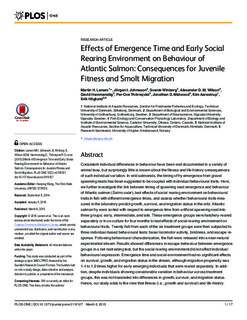| dc.description.abstract | Consistent individual differences in behaviour have been well documented in a variety of animal taxa, but surprisingly little is known about the fitness and life-history consequences of such individual variation. In wild salmonids, the timing of fry emergence from gravel spawning nests has been suggested to be coupled with individual behavioural traits. Here, we further investigate the link between timing of spawning nest emergence and behaviour of Atlantic salmon (Salmo salar), test effects of social rearing environment on behavioural traits in fish with different emergence times, and assess whether behavioural traits measured in the laboratory predict growth, survival, and migration status in the wild. Atlantic salmon fry were sorted with respect to emergence time from artificial spawning nest into three groups: early, intermediate, and late. These emergence groups were hatchery-reared separately or in co-culture for four months to test effects of social rearing environment on behavioural traits. Twenty fish from each of the six treatment groups were then subjected to three individual-based behavioural tests: basal locomotor activity, boldness, and escape response. Following behavioural characterization, the fish were released into a near-natural experimental stream. Results showed differences in escape behaviour between emergence groups in a net restraining test, but the social rearing environment did not affect individual behavioural expression. Emergence time and social environment had no significant effects on survival, growth, and migration status in the stream, although migration propensity was 1.4 to 1.9 times higher for early emerging individuals that were reared separately. In addition, despite individuals showing considerable variation in behaviour across treatment groups, this was not translated into differences in growth, survival, and migration status. Hence, our study adds to the view that fitness (i.e., growth and survival) and life-history predictions from laboratory measures of behaviour should be made with caution and ideally tested in nature. | nb_NO |
